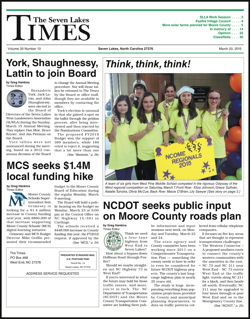 The smell of asphalt may soon punctuate the Summer heat in Seven Lakes North and South.
The smell of asphalt may soon punctuate the Summer heat in Seven Lakes North and South.
The Seven Lakes Landowners Association [SLLA] Board of Directors, during the Wednesday, June 26 Open Meeting, unanimously approved moving forward with Phase 1 of a sixteen-year plan for paving SLLA streets.
President Bob Darr presented an abbreviated version of the plan that he rolled out at the Board's June 11 Work Session, and the Directors voted unanimously to proceed with the first phase of the plan, at a cost not to exceed $575,000. [Read our report on that presentation; download Darr's flip charts.]
That amount, which can be covered with funds available in SLLA reserve accounts, will allow the Association to repair the worst areas, where pavement is actually breaking up or being damaged by tree roots, as well as sections of pavement that the engineering firm S&ME has classified as having five years or less of usable life.
"Where we are right now is that we are about ready to accept proposals from the paving companies to actually get a contract," Darr explained.
"We have the numbers almost totally solidified," he continued. "We have basically picked the contractor. We will be taking what we have put together to the contractor to ask: Will you do it for this price? We think our numbers will hold up and we will get a contract. I am really hopeful and quite excited about it, quite frankly. If we can get it altogether, they might be able to start paving on the ninth [July 9]."
"We will have one heck of a mess at the gates" during paving in that area, Darr said, adding that the extensive work required to repair areas of Dogwood Lane that have tree root damage will also create so inconvenience for residents.
Traffic will need to be rerouted at various points in the process, and the details of how that will be handled will be posted on the Association's newly redesigned website, at www.sevenlakesnc.org. Darr said it could take three to five days to complete paving in the gate area.
The initial round of paving will include two types of surface, Darr explained during the June 11 Work Session. The "Cape Seal" technique involves spreading tar and gravel, rolling it, and then topping it with slurry, the liquid asphalt sealer recently used on Seven Lakes Drive.
The other technique uses a layer of asphalt in place of the slurry. Darr said there is some debate in the paving community about which application is better; he declined to provide cost comparisons of the two techniques. Both options will be used on different sections of SLLA streets in Phase 1 of the repaving project, allowing the Board and Community to evaluate which should be used in future repaving efforts.
The Board, during Wednesday's Open Meeting, approved only Phase 1 of the paving plan. The total plan stretches sixteen years into the future, spacing the work based on S&ME's assessment of the likely lifespan of various stretches of pavement and on the availability of funds to pay for the work. The Association reserves $100 of each landowner's annual dues for road repaving and state-mandated dam repairs.
If nothing else places a demand on those funds -- and the price of asphalt does no rise significantly -- then the paving reserves will cover the cost of future paving planned. But Darr said he is skeptical that the stars will align so perfectly.
"If paving costs don't increase in next 16 years, if roads don't deteriorate, If we don't need to do crack sealing, if we have no state mandated dam repairs, then we can do it and we won't have to ask for a road-paving related dues increase," Darr said.
"If all of that stuff lines up, that will happen. I don't think, quite frankly, that we can make those kind of assumptions."
